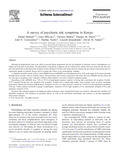A survey of psychosis risk symptoms in Kenya
Date
2012Author
Mamah, D
Mbwayo, A
Mutiso, V
Barch, DM
Constantino, JN
Nsofor, T
Khasakhala, L
Ndetei David M.
Type
ArticleLanguage
enMetadata
Show full item recordAbstract
Defining the prepsychotic state in an effort to prevent illness progression and the development of disorders such as schizophrenia is a rapidly growing area of psychiatry. The presentation of psychotic symptoms can be influenced by culture; however, there has not been any previous assessment of psychosis risk symptoms in the continent of Africa. Our study aimed to measure the prevalence of psychosis risk in a community sample in Nairobi, Kenya, and to evaluate the effects of key demographic variables. A culturally modified version of the 12-item PRIME-Screen (mPRIME) was self-administered by 2758 youth (aged 14-29 years) recruited through house-to-house visits in Nairobi, Kenya. The prevalence and severity of psychosis risk items from the mPRIME and the effects of sex and age on symptoms were evaluated. k-Means cluster analysis was used to identify symptom groups. Depending on the mPRIME item, 1.8% to 19.5% of participants reported certainty of having had a psychosis risk symptom. Overall, 45.5% reported having had any psychosis risk symptom. Females had a significantly higher mean severity score on items evaluating persecutory ideation and auditory hallucinations. Symptom severity on 5 items showed a modest (R = 0.09-0.13) but significant correlation with age. Cluster analysis identified 4 groups of participants: normative (55%), high symptom (11%), intermediate symptom (19%), and grandiose symptom (15%). Psychosis risk symptoms appear to be highly prevalent in Kenyan youth. Longitudinal studies are needed to determine the correlation of identified symptoms with transition to psychotic illness, as well as the associated functionality and distress, to develop appropriate intervention strategies
URI
http://www.ncbi.nlm.nih.gov/pmc/articles/PMC3265657/http://erepository.uonbi.ac.ke:8080/xmlui/handle/123456789/17297
http://www.sciencedirect.com/science/article/pii/S0010440X11001611
http://www.ncbi.nlm.nih.gov/pubmed/21945193
Citation
Compr Psychiatry. 2012 Jul;53(5):516-24Publisher
Department of Psychiatry, Washington University School of Medicine, Department of Psychiatry, University of Nairobi, Nairobi, Kenya;
Collections
- Faculty of Health Sciences (FHS) [10377]

